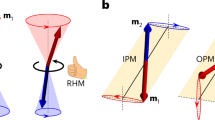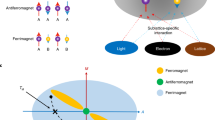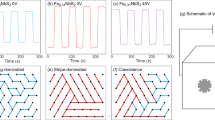Abstract
Antiferromagnetic materials are internally magnetic, but the direction of their ordered microscopic moments alternates between individual atomic sites. The resulting zero net magnetic moment makes magnetism in antiferromagnets externally invisible. This implies that information stored in antiferromagnetic moments would be invisible to common magnetic probes, insensitive to disturbing magnetic fields, and the antiferromagnetic element would not magnetically affect its neighbours, regardless of how densely the elements are arranged in the device. The intrinsic high frequencies of antiferromagnetic dynamics represent another property that makes antiferromagnets distinct from ferromagnets. Among the outstanding questions is how to manipulate and detect the magnetic state of an antiferromagnet efficiently. In this Review we focus on recent works that have addressed this question. The field of antiferromagnetic spintronics can also be viewed from the general perspectives of spin transport, magnetic textures and dynamics, and materials research. We briefly mention this broader context, together with an outlook of future research and applications of antiferromagnetic spintronics.
This is a preview of subscription content, access via your institution
Access options
Subscribe to this journal
Receive 12 print issues and online access
$259.00 per year
only $21.58 per issue
Buy this article
- Purchase on Springer Link
- Instant access to full article PDF
Prices may be subject to local taxes which are calculated during checkout







Similar content being viewed by others
References
Néel, L. Magnetism and the local molecular field. Nobel Lectures, Physics 1963–1970 (1970).
MacDonald, A. H. & Tsoi, M. Antiferromagnetic metal spintronics. Phil. Trans. R. Soc. A 369, 3098–3114 (2011).
Shick, A. B., Khmelevskyi, S., Mryasov, O. N., Wunderlich, J. & Jungwirth, T. Spin-orbit coupling induced anisotropy effects in bimetallic antiferromagnets: a route towards antiferromagnetic spintronics. Phys. Rev. B 81, 212409 (2010).
Železný, J. et al. Relativistic Néel-order fields induced by electrical current in antiferromagnets. Phys. Rev. Lett. 113, 157201 (2014).
Gomonay, E. V. & Loktev, V. Spintronics of antiferromagnetic systems (review article). Low Temp. Phys. 40, 17–35 (2014).
Parkin, S. et al. Magnetically engineered spintronic sensors and memory. Proc. IEEE 91, 661–679 (2003).
Chappert, C., Fert, A. & Van Dau, F. N. The emergence of spin electronics in data storage. Nature Mater. 6, 813–823 (2007).
Park, B. G. et al. A spin-valve-like magnetoresistance of an antiferromagnet-based tunnel junction. Nature Mater. 10, 347–351 (2011).
Loth, S., Baumann, S., Lutz, C. P., Eigler, D. M. & Heinrich, A. J. Bistability in atomic-scale antiferromagnets. Science 335, 196–198 (2012).
Marti, X. et al. Room-temperature antiferromagnetic memory resistor. Nature Mater. 13, 367–374 (2014).
Wadley, P. et al. Electrical switching of an antiferromagnet. Science 351, 587–590 (2016).
Moriyama, T. et al. Sequential write-read operations in FeRh antiferromagnetic memory. Appl. Phys. Lett. 107, 122403 (2015).
Nogués, J. & Schuller, I. K. Exchange bias. J. Magn. Magn. Mater. 192, 203–232 (1999).
Scholl, A., Liberati, M., Arenholz, E., Ohldag, H. & Stöhr, J. Creation of an antiferromagnetic exchange spring. Phys. Rev. Lett. 92, 247201 (2004).
Duine, R. Spintronics: an alternating alternative. Nature Mater. 10, 344–345 (2011).
Wang, Y. Y. et al. Room-temperature perpendicular exchange coupling and tunneling anisotropic magnetoresistance in an antiferromagnet-based tunnel junction. Phys. Rev. Lett. 109, 137201 (2012).
Ralph, D. Spintronics research at Cornell. KITP Progr. Spintron. http://go.nature.com/CdkJ8G (2013).
Fina, I. et al. Anisotropic magnetoresistance in an antiferromagnetic semiconductor. Nature Commun. 5, 4671 (2014).
Wang, Y. Y., Song, C., Wang, G. Y., Zeng, F. & Pan, F. Evidence for asymmetric rotation of spins in antiferromagnetic exchange-spring. New J. Phys. 16, 123032 (2014).
Ralph, D. & Stiles, M. D. Spin transfer torques. J. Magn. Magn. Mater. 320, 1190–1216 (2008).
Gomonay, H. V. & Loktev, V. M. Spin transfer and current-induced switching in antiferromagnets. Phys. Rev. B 81, 144427 (2010).
Núñez, A., Duine, R., Haney, P. & MacDonald, A. H. Theory of spin torques and giant magnetoresistance in antiferromagnetic metals. Phys. Rev. B 73, 214426 (2006).
Saidaoui, H. B. M., Manchon, A. & Waintal, X. Spin transfer torque in antiferromagnetic spin valves: from clean to disordered regimes. Phys. Rev. B 89, 174430 (2014).
Wei, Z. et al. Changing exchange bias in spin valves with an electric current. Phys. Rev. Lett. 98, 116603 (2007).
Gomonay, H. V., Kunitsyn, R. V. & Loktev, V. M. Symmetry and the macroscopic dynamics of antiferromagnetic materials in the presence of spin-polarized current. Phys. Rev. B 85, 134446 (2012).
Prakhya, K., Popescu, A. & Haney, P. M. Current-induced torques between ferromagnets and compensated antiferromagnets: symmetry and phase coherence effects. Phys. Rev. B 89, 054421 (2014).
Cheng, R. & Niu, Q. Dynamics of antiferromagnets driven by spin current. Phys. Rev. B 89, 081105 (2014).
Tang, X. L., Zhang, H. W., Su, H., Zhong, Z. Y. & Jing, Y. L. Changing and reversing the exchange bias in a current-in-plane spin valve by means of an electric current. Appl. Phys. Lett. 91, 122504 (2007).
Urazhdin, S. & Anthony, N. Effect of polarized current on the magnetic state of an antiferromagnet. Phys. Rev. Lett. 99, 046602 (2007).
Dai, N. V. et al. Impact of in-plane currents on magnetoresistance properties of an exchange-biased spin valve with an insulating antiferromagnetic layer. Phys. Rev. B 77, 132406 (2008).
Tang, X., Su, H., Zhang, H. W., Jing, Y. L. & Zhong, Z. Y. Tuning the direction of exchange bias in ferromagnetic/antiferromagnetic bilayer by angular-dependent spin-polarized current. J. Appl. Phys. 112, 073916 (2012).
McGuire, T. & Potter, R. Anisotropic magnetoresistance in ferromagnetic 3D alloys. IEEE Trans. Magn. 11, 1018–1038 (1975).
Daughton, J. Magnetoresistive memory technology. Thin Solid Films 216, 162–168 (1992).
Zhang, X. & Zou, L. K. Planar Hall effect in Y3Fe5O12/IrMn films. Appl. Phys. Lett. 105, 262401 (2014).
Wong, A. T. et al. Strain driven anisotropic magnetoresistance in antiferromagnetic La0.4Sr0.6MnO3 . Appl. Phys. Lett. 105, 052401 (2014).
Kriegner, D. et al. Multiple-stable anisotropic magnetoresistance memory in antiferromagnetic MnTe. Preprint at http://arxiv.org/abs/1508.04877 (2015).
Petti, D. et al. Storing magnetic information in IrMn/MgO/Ta tunnel junctions via field-cooling. Appl. Phys. Lett. 102, 192404 (2013).
Sinova, J., Valenzuela, S. O., Wunderlich, J., Back, C. H. & Jungwirth, T. Spin Hall effects. Rev. Mod. Phys. 87, 1213–1260 (2015).
Shull, C. G. & Smart, J. S. Detection of antiferromagnetism by neutron diffraction. Phys. Rev. 76, 1256–1257 (1949).
Shull, C., Chase, C. & Myers, F. Electron polarization. Phys. Rev. 63, 29–37 (1943).
Mott, N. F. The scattering of fast electrons by atomic nuclei. Proc. R. Soc. A Math. Phys. Eng. Sci. 124, 425–442 (1929).
Miron, I. M. et al. Perpendicular switching of a single ferromagnetic layer induced by in-plane current injection. Nature 476, 189–193 (2011).
Liu, L. et al. Spin-torque switching with the giant spin Hall effect of tantalum. Science 336, 555–558 (2012).
Acharyya, R., Nguyen, H. Y. T., Pratt, W. P. & Bass, J. A study of spin-flipping in sputtered IrMn using Py-based exchange-biased spin-valves. J. Appl. Phys. 109, 07C503 (2011).
Reichlová, H. et al. Current induced torques in structures with ultra-thin IrMn antiferromagnet. Phys. Rev. B 92, 165424 (2015).
Kato, Y. K., Myers, R. C., Gossard, A. C. & Awschalom, D. D. Observation of the spin Hall effect in semiconductors. Science 306, 1910–1913 (2004).
Kato, Y. K., Myers, R. C., Gossard, A. C. & Awschalom, D. D. Current-induced spin polarization in strained semiconductors. Phys. Rev. Lett. 93, 176601 (2004).
Wunderlich, J., Kaestner, B., Sinova, J. & Jungwirth, T. Experimental discovery of the spin-Hall effect in Rashba spin-orbit coupled semiconductor systems. Preprint at http://arxiv.org/abs/cond-mat/0410295v1 (2004).
Wunderlich, J., Kaestner, B., Sinova, J. & Jungwirth, T. Experimental observation of the spin-Hall effect in a two dimensional spin-orbit coupled semiconductor system. Phys. Rev. Lett. 94, 047204 (2005).
Silov, A. Y. et al. Current-induced spin polarization at a single heterojunction. Appl. Phys. Lett. 85, 5929–5931 (2004).
Ganichev, S. D. et al. Can an electric current orient spins in quantum wells? Preprint at http://arxiv.org/abs/cond-mat/0403641 (2004).
Bernevig, B. A. & Vafek, O. Piezo-magnetoelectric effects in p-doped semiconductors. Phys. Rev. B 72, 033203 (2005).
Chernyshov, A. et al. Evidence for reversible control of magnetization in a ferromagnetic material by means of spin–orbit magnetic field. Nature Phys. 5, 656–659 (2009).
Zhang, X., Liu, Q., Luo, J.-W., Freeman, A. J. & Zunger, A. Hidden spin polarization in inversion-symmetric bulk crystals. Nature Phys. 10, 387–393 (2014).
Ciccarelli, C. et al. Room-temperature spin-orbit torque in NiMnSb. Preprint at http://arxiv.org/abs/1510.03356 (2015).
Wadley, P. et al. Tetragonal phase of epitaxial room-temperature antiferromagnet CuMnAs. Nature Commun. 4, 2322 (2013).
Wu, H. C. et al. Mn2Au: body-centered-tetragonal bimetallic antiferromagnets grown by molecular beam epitaxy. Adv. Mater. 24, 6374–6379 (2012).
Barthem, V. M. T. S., Colin, C. V., Mayaffre, H., Julien, M.-H. & Givord, D. Revealing the properties of Mn2Au for antiferromagnetic spintronics. Nature Commun. 4, 2892 (2013).
Olejník, K., Novák, V., Wunderlich, J. & Jungwirth, T. Electrical detection of magnetization reversal without auxiliary magnets. Phys. Rev. B 91, 180402 (2015).
Avci, C. O. et al. Unidirectional spin Hall magnetoresistance in ferromagnet/normal metal bilayers. Nature Phys. 11, 570–575 (2015).
Keffer, F. & Kittel, C. Theory of antiferromagnetic resonance. Phys. Rev. 85, 329–337 (1952).
Kimel, A. V., Kirilyuk, A., Tsvetkov, A., Pisarev, R. V. & Rasing, T. Laser-induced ultrafast spin reorientation in the antiferromagnet TmFeO3 . Nature 429, 850–853 (2004).
Fiebig, M. et al. Ultrafast magnetization dynamics of antiferromagnetic compounds. J. Phys. D 41, 164005 (2008).
Kampfrath, T. et al. Coherent terahertz control of antiferromagnetic spin waves. Nature Photon. 5, 31–34 (2010).
Satoh, T. et al. Spin oscillations in antiferromagnetic NiO triggered by circularly polarized light. Phys. Rev. Lett. 105, 077402 (2010).
Satoh, T., Iida, R., Higuchi, T., Fiebig, M. & Shimura, T. Writing and reading of an arbitrary optical polarization state in an antiferromagnet. Nature Photon. 9, 25–29 (2014).
Schumacher, H. W. et al. Phase coherent precessional magnetization reversal in microscopic spin valve elements. Phys. Rev. Lett. 90, 017201 (2003).
Hals, K. M. D., Tserkovnyak, Y. & Brataas, A. Phenomenology of current-induced dynamics in antiferromagnets. Phys. Rev. Lett. 106, 107206 (2011).
Swaving, A. C. & Duine, R. A. Current-induced torques in continuous antiferromagnetic textures. Phys. Rev. B 83, 054428 (2011).
Cheng, R. & Niu, Q. Electron dynamics in slowly varying antiferromagnetic texture. Phys. Rev. B 86, 245118 (2012).
Tveten, E. G., Qaiumzadeh, A., Tretiakov, O. & Brataas, A. Staggered dynamics in antiferromagnets by collective coordinates. Phys. Rev. Lett. 110, 127208 (2013).
Tveten, E. G., Qaiumzadeh, A. & Brataas, A. Antiferromagnetic domain wall motion induced by spin waves. Phys. Rev. Lett. 112, 147204 (2014).
Gomonay, O. Berry-phase effects and electronic dynamics in a noncollinear antiferromagnetic texture. Phys. Rev. B 91, 144421 (2015).
Tveten, E. G., Tristan, M., Linder, J. & Brataas, A. The intrinsic magnetization of antiferromagnetic textures. Preprint at http://arxiv.org/abs/1506.06561 (2015).
Zhang, X., Zhou, Y. & Ezawa, M. Antiferromagnetic skyrmion: stability, creation and manipulation. Preprint at http://arxiv.org/abs/1504.01198 (2015).
Barker, J. & Tretiakov, O. A. Antiferromagnetic skyrmions. Preprint at http://arxiv.org/abs/1505.06156 (2015).
Takei, S. & Tserkovnyak, Y. Superfluid spin transport through antiferromagnetic insulators. Phys. Rev. B 90, 094408 (2014).
Wang, H., Du, C., Hammel, P. C. & Yang, F. Antiferromagnonic spin transport from Y3Fe5O12 into NiO. Phys. Rev. Lett. 113, 097202 (2014).
Hahn, C. et al. Conduction of spin currents through insulating antiferromagnetic oxides. Europhys. Lett. 108, 57005 (2014).
Moriyama, T. et al. Anti-damping spin transfer torque through epitaxial nickel oxide. Appl. Phys. Lett. 106, 162406 (2015).
Takei, S., Moriyama, T., Ono, T. & Tserkovnyak, Y. Antiferromagnet-mediated spin transfer between a metal and a ferromagnet. Phys. Rev. B 92, 020409 (2015).
Ohnuma, Y., Adachi, H., Saitoh, E. & Maekawa, S. Spin Seebeck effect in antiferromagnets and compensated ferrimagnets. Phys. Rev. B 87, 014423 (2013).
Cheng, R., Xiao, J., Niu, Q. & Brataas, A. Spin pumping and spin-transfer torques in antiferromagnets. Phys. Rev. Lett. 113, 057601 (2014).
Brataas, A., Skarsvåg, H., Tveten, E. G. & Fjærbu, E. L Heat transport between antiferromagnetic insulators and normal metals. Phys. Rev. B 92, 180414 (2015).
Wu, S. M. et al. Antiferromagnetic spin Seebeck effect. Preprint at http://arxiv.org/abs/1509.00439 (2015).
Seki, S. et al. Thermal generation of spin current in an antiferromagnet. Phys. Rev. Lett. 115, 266601 (2015).
Tshitoyan, V. et al. Electrical manipulation of ferromagnetic NiFe by antiferromagnetic IrMn. Phys. Rev. B 92, 214406 (2015).
Fukami, S., Zhang, C., Duttagupta, S. & Ohno, H. Magnetization switching by spin-orbit torque in an antiferromagnet/ferromagnet bilayer system. Preprint at http://arxiv.org/abs/1507.00888 (2015).
Mendes, J. B. S. et al. Large inverse spin Hall effect in the antiferromagnetic metal Ir20Mn80 . Phys. Rev. B 89, 140406 (2014).
Zhang, W. et al. Spin Hall effects in metallic antiferromagnets. Phys. Rev. Lett. 113, 196602 (2014).
Uchida, K. et al. Observation of longitudinal spin-Seebeck effect in magnetic insulators. Appl. Phys. Lett. 97, 172505 (2010).
Sando, D. et al. Crafting the magnonic and spintronic response of BiFeO3 films by epitaxial strain. Nature Mater. 12, 641–646 (2013).
Wu, S. M. et al. Full electric control of exchange bias. Phys. Rev. Lett. 110, 067202 (2013).
Jungwirth, T. et al. Demonstration of molecular beam epitaxy and a semiconducting band structure for I-Mn-V compounds. Phys. Rev. B 83, 035321 (2011).
Cava, R. A useful pyramid scheme. Physics 4, 7 (2011).
Dietl, T. & Ohno, H. Dilute ferromagnetic semiconductors: physics and spintronic structures. Rev. Mod. Phys. 86, 187–251 (2014).
Jungwirth, T. et al. Spin-dependent phenomena and device concepts explored in (Ga,Mn)As. Rev. Mod. Phys. 86, 855–896 (2014).
Máca, F. et al. Room-temperature antiferromagnetism in CuMnAs. J. Magn. Magn. Mater. 324, 1606–1612 (2012).
Beleanu, A. et al. Large resistivity change and phase transition in the antiferromagnetic semiconductors LiMnAs and LaOMnAs. Phys. Rev. B 88, 184429 (2013).
Kim, B. J. et al. Phase-sensitive observation of a spin-orbital Mott state in Sr2IrO4 . Science 323, 1329–1332 (2009).
Wang, C. et al. Anisotropic magnetoresistance in antiferromagnetic Sr2IrO4 . Phys. Rev. X 4, 041034 (2014).
Chen, H., Niu, Q. & MacDonald, A. H. Anomalous Hall effect arising from noncollinear antiferromagnetism. Phys. Rev. Lett. 112, 017205 (2014).
Nakatsui, S., Kiyohara, N. & Higo, T. Large anomalous Hall effect in a non-collinear antiferromagnet at room temperature. Nature 527, 212–215 (2015).
Norman, M. R. The challenge of unconventional superconductivity. Science 332, 196–200 (2011).
Bruno, P. in Magnetism: Molecules to Materials III Vol. 2 (eds Miller, J. S. & Drillon, M.) 329–353 (Wiley, 2002).
Baibich, M. N. et al. Giant magnetoresistance of (001)Fe/(001)Cr magnetic superlattices. Phys. Rev. Lett. 61, 2472–2475 (1988).
Binasch, G., Grunberg, P., Saurenbach, F. & Zinn, W. Enhanced magnetoresistance in layered magnetic structures. Phys. Rev. B 39, 4828–4830 (1989).
Wolf, S. A. et al. Spintronics: a spin-based electronics vision for the future. Science 294, 1488–1495 (2001).
Engel, B. N. et al. A 4-Mb toggle MRAM based on a novel bit and switching method. IEEE Trans. Magn. 41, 132–136 (2005).
Saarikoski, H., Kohno, H., Marrows, C. H. & Tatara, G. Current-driven dynamics of coupled domain walls in a synthetic antiferromagnet. Phys. Rev. B 90, 094411 (2014).
Yang, S.-H., Ryu, K.-S. & Parkin, S. Domain-wall velocities of up to 750 m s−1 driven by exchange-coupling torque in synthetic antiferromagnets. Nature Nanotech. 10, 221–226 (2015).
Li, Q. et al. Activation of antiferromagnetic domain switching in exchange-coupled Fe/CoO/MgO(001) systems. Phys. Rev. B 91, 134428 (2015).
Wunderlich, J. et al. Coulomb blockade anisotropic magnetoresistance effect in a (Ga,Mn)As single-electron transistor. Phys. Rev. Lett. 97, 077201 (2006).
Ciccarelli, C. et al. Spin gating electrical current. Appl. Phys. Lett. 101, 122411 (2012).
Coey, J. M. D. Louis Néel: retrospective (invited). J. Appl. Phys. 93, 8224–8229 (2003).
Gomory, F. et al. Experimental realization of a magnetic cloak. Science 335, 1466–1468 (2012).
Serga, A., Chumak, A. V. & Hillebrands, B. YIG magnonics. J. Phys. D 43, 264002 (2010).
Acknowledgements
We acknowledge support from the EU European Research Council (Advanced Grant No. 268066), the Ministry of Education of the Czech Republic (Grant No. LM2011026) and the Grant Agency of the Czech Republic (Grant No. 14-37427).
Author information
Authors and Affiliations
Corresponding author
Ethics declarations
Competing interests
The authors declare no competing financial interests.
Rights and permissions
About this article
Cite this article
Jungwirth, T., Marti, X., Wadley, P. et al. Antiferromagnetic spintronics. Nature Nanotech 11, 231–241 (2016). https://doi.org/10.1038/nnano.2016.18
Received:
Accepted:
Published:
Issue Date:
DOI: https://doi.org/10.1038/nnano.2016.18
This article is cited by
-
Recent trends in preparation and biomedical applications of iron oxide nanoparticles
Journal of Nanobiotechnology (2024)
-
New type of magnetism splits from convention
Nature (2024)
-
Phase transitions associated with magnetic-field induced topological orbital momenta in a non-collinear antiferromagnet
Nature Communications (2024)
-
Altermagnetism with non-collinear spins
npj Quantum Materials (2024)
-
Dipolar spin wave packet transport in a van der Waals antiferromagnet
Nature Physics (2024)



